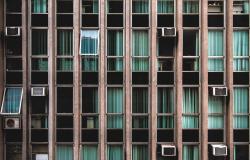COVID-19 and the Urgent Need to Render Spaces Safer

Why we should emulate the US Air Force’s “integrated air defence” approach to move out of lockdown.
The world is rapidly changing as a result of the worst pandemic since the Spanish flu of 1918 in which 50-100 million people worldwide died. At a time of major divisiveness and unique electoral repercussions, the geopolitical dimensions of the new pandemic of coronavirus disease 2019 (COVID-19) are as menacing to the political and economic stability as the infection is to an individual’s health and wellbeing.
With COVID-19, social distancing and the use of masks have become the new norm. There is a tangible threat carried by droplets and aerosol particles containing this virus, which may spread unwittingly to people and surfaces, contaminating them. We need now consider how to manipulate the air that carries this virus within our buildings, automobiles, buses and airplanes.
More may be needed than social distancing, cleaning surfaces widely, covering mouths with masks, and being careful of how people touch themselves and others as well as objects. Cleaning the air from this threat and further reducing COVID-19 transmission remains a concern. The world changed with this new pandemic; mandating evaluation of ventilation systems.
Indoor ventilation systems are designed to provide heating and cooling, and are subject to many safety requirements. They normally provide 1 to 2 air changes per hour. Their ability to simultaneously guard against a circulating threat within a confined space is not usually considered, but can be readily accommodated. Furthermore, atmospheric viral particulate survival is related to specific temperature and relative humidity conditions. The atmospheric viral inactivation rate is enhanced by an increase in temperature and solar radiation.
Studies of airborne diseases such as tuberculosis and measles have shown that transmission via droplet spread is extensive in a normal environment. Extensive testing has documented that every time one doubles the air changes per hour in a room, the contaminant load is cut in half. The human infectivity is also halved with every doubling of a room air exchange. These observations should encourage efforts to increase the relative air room changes per hour or otherwise modifying the air to decrease the potential for human infections caused by an airborne disease vector.
Therefore, an important weapon in our war against COVID-19 should be utilized by modifying the air and minimizing or eliminating the danger within enclosed spaces! After all, room ventilation limits aerosol transmission of SARS-CoV-2.
There are at least two methods of cleansing the air containing this virus: these solutions work equally well whether in a waiting room, a commercial airliner, a cruise ship or a sports arena:
1. Air Scrubbing can be accomplished employing a device that decontaminates and then recirculates the air within a room without having to change the indoor ventilation system itself. This indoor air cleaning includes high efficiency air filtration along with internal high output ultraviolet light-C range irradiation. Standalone and portable, air turnover units incorporating these proven components will go a long way to achieving air that contains low levels of infectious agent contamination. This approach has been done successfully against mold air contaminants and is itself relatively inexpensive, one also merited against the new global epidemic of Candida auris, a fungal nosocomial threat comparable to SARS-CoV-2 in its mortality and fomite adhesiveness.
2. Cleaning the air with a chemical mist is another well tolerated approach. This goal can be accomplished by devices using hydrogen peroxide or hypochlorous acid. Some are available already, approved by the U.S. Occupational Safety and Health Administration (OSHA) and Federal Drug Administration (FDA). They can be simply plugged in to a wall socket or spliced into a heating ventilation and air conditioning system.
These approaches would protect against the lingering effects of an aerosolized virus, but would be insufficient against a forceful sneeze or cough. This protection requires some type of a mask to reduce the distance a cough or sneeze propagates. The virus aerosol deposition on protective apparel or floor surface and their subsequent resuspension mandates effective sanitization as critical.
We suggest an “integrated air defence” as has already begun implementation in the United States Air Force. Since it is unknown who is currently infected, it must be assumed that everyone is infected and plan accordingly. A focus on clean air is long overdue!
Lieutenant General (Ret.) Paul K. Carlton Jr. MD, FACS , Surgeon General of the United States Air Force, 1999-2002.
Jay Johanigman MD, FACS, Professor, University of Cincinnati College of Medicine.
Edmund J. Janniger OLJ, President, International Security Forum.
Robert A. Schwartz MD, MPH, DSc (Hon), FRCP Edin, Professor and Head of Dermatology, Rutgers New Jersey Medical School.


